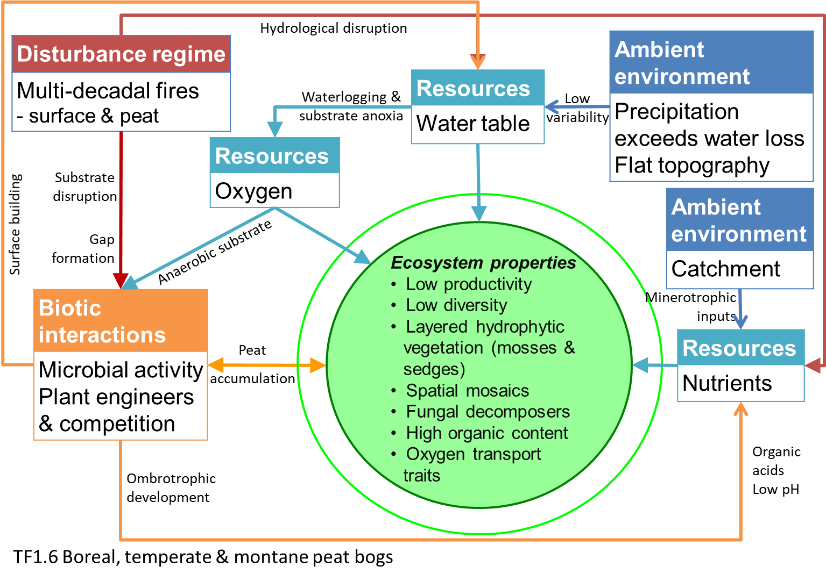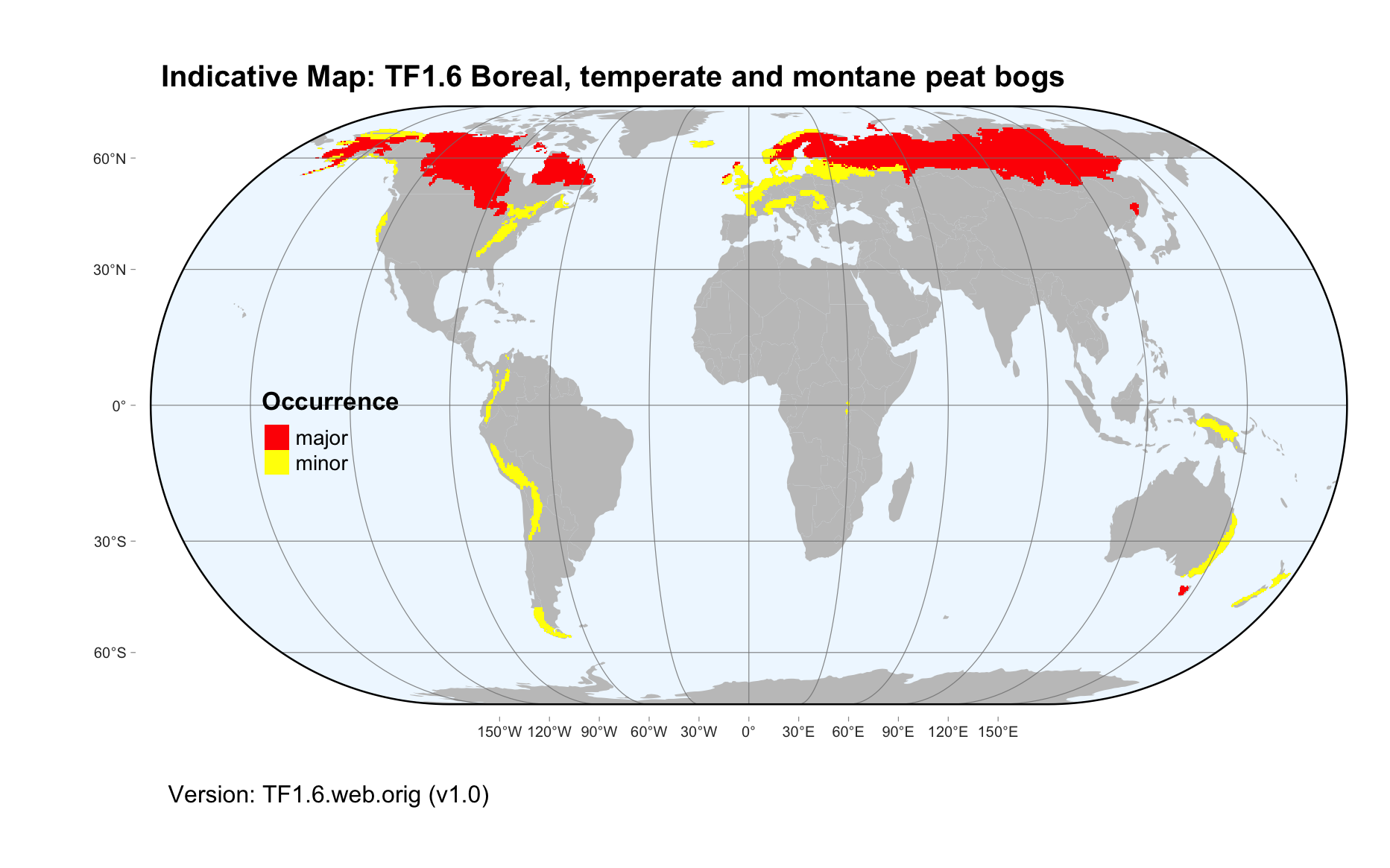Global ecosystem typology
Alternative site for the Global ecosystem typology with additional information for ecosystem profiles and indicative maps.
This site is maintained by jrfep
TF1.6 Boreal, temperate and montane peat bogs
Biome: TF1. Palustrine wetlands biome
Contributors:
(texts)
Peat bogs in the boreal-subarctic and temperate areas of the world account for up to 40% of the world’s soil carbon. They are landscape sponges, with highly specialised plant life including shrubs, sedges and mosses equipped to grow in acidic, nutrient-poor, low-oxygen, waterlogged soils. Sphagnum moss and other peat-forming plants are foundational to these ecosystems. Insects are the dominant animal group, along with amphibians, reptiles, rodents and a few visiting birds.
Key Features
Permanently ground water-logged (by rainwater-fed ground water,) nutrient poor, acidic sites on organic soils (peat); species poor, but high abundance of mosses, sedges and no to open woody species cover.
Overview of distribution
Boreal and temperate humid zones of the northern hemisphere, limited occurrences in the southern hemisphere (southern South America, southern Australasia).
Profile versions
- v1.0 (2020-05-31): DA Keith; RT Kingsford; F Essl; LJ Jackson; T Tahvanainen
- v2.0 (2020-06-17): DA Keith; RT Kingsford; F Essl; LJ Jackson; M Kelly-Quinn; KR Young; T Tahvanainen
- v2.01 ():
- v2.1 (2022-04-06): DA Keith; RT Kingsford; F Essl; LJ Jackson; M Kelly-Quinn; KR Young; T Tahvanainen Full profile available at official site
Main references
Selected references for this functional group:
Wieder RK, Vitt DH (2006) Boreal peatland ecosystems Ecological studies vol. 188. Springer-Verlag, Berlin
Palozzi JE, Lindo Z (2017) Boreal peat properties link to plant functional traits of ecosystem engineers Plant and Soil 418: 277-291
Diagrammatic assembly model

Maps
Maps are indicative of global distribution patterns are not intended to represent fine-scale patterns. The maps show areas of the world containing major (coloured red) or minor occurrences (coloured yellow) of each ecosystem functional group. See general notes on maps.
There are 2 alternative versions of the indicative map for this functional group, please compare description and sources below.
TF1.6.IM.orig_v1.0
Datasets
- Resolve-Ecoregions-2017
Map references
Dinerstein E, Olson D, Joshi A, Vynne C, Burgess ND, Wikramanayake E, Hahn N, Palminteri S, Hedao P, Noss R, Hansen M, Locke H, Ellis EE, Jones B, Barber CV, Hayes R, Kormos C, Martin V, Crist E, Sechrest W, Price L, Baillie JEM, Weeden D, Suckling K, Davis C, Sizer N, Moore R, Thau D, Birch T, Potapov P, Turubanova S, Tyukavina A, de Souza N, Pintea L, Brito JC, Llewellyn Barnekow Lillesø JP, van Breugel P, Graudal L, Voge M, Al-Shammari KF, Saleem M (2017) An Ecoregion-Based Approach to Protecting Half the Terrestrial Realm, BioScience 67: 534–545. DOI:10.1093/biosci/bix014. Data-set available on-line
TF1.6.web.orig_v1.0

Datasets
- Resolve-Ecoregions-2017
Map references
Dinerstein E, Olson D, Joshi A, Vynne C, Burgess ND, Wikramanayake E, Hahn N, Palminteri S, Hedao P, Noss R, Hansen M, Locke H, Ellis EE, Jones B, Barber CV, Hayes R, Kormos C, Martin V, Crist E, Sechrest W, Price L, Baillie JEM, Weeden D, Suckling K, Davis C, Sizer N, Moore R, Thau D, Birch T, Potapov P, Turubanova S, Tyukavina A, de Souza N, Pintea L, Brito JC, Llewellyn Barnekow Lillesø JP, van Breugel P, Graudal L, Voge M, Al-Shammari KF, Saleem M (2017) An Ecoregion-Based Approach to Protecting Half the Terrestrial Realm, BioScience 67: 534–545. DOI:10.1093/biosci/bix014. Data-set available on-line
Check: the Glossary / Profile structure / the public document